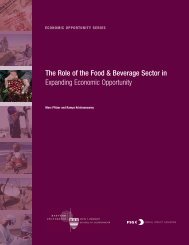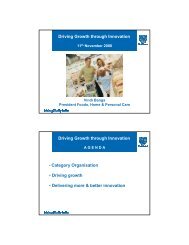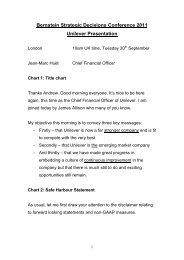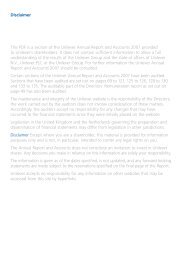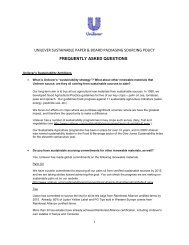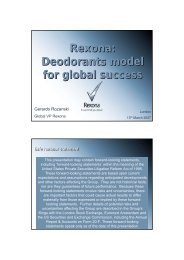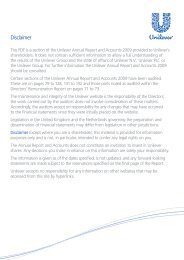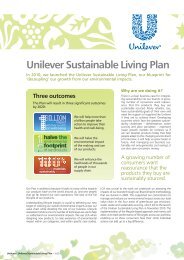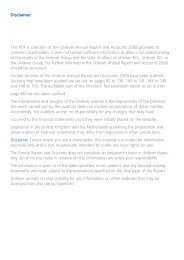Annual Report & Accounts 2010: Outlook and risks - Unilever
Annual Report & Accounts 2010: Outlook and risks - Unilever
Annual Report & Accounts 2010: Outlook and risks - Unilever
You also want an ePaper? Increase the reach of your titles
YUMPU automatically turns print PDFs into web optimized ePapers that Google loves.
<strong>Report</strong> of the Directors About <strong>Unilever</strong><br />
<strong>Outlook</strong> <strong>and</strong> <strong>risks</strong> continued<br />
Description of risk What we are doing to manage the risk<br />
Consumer safety <strong>and</strong> sustainability<br />
• Maintaining high social <strong>and</strong> environmental st<strong>and</strong>ards<br />
• Designing <strong>and</strong> producing products that are safe<br />
for consumers<br />
• Building a sustainable business<br />
<strong>Unilever</strong> has developed a strong corporate reputation over many years<br />
for its focus on social <strong>and</strong> environmental issues, including promoting<br />
sustainable renewable resources.<br />
The <strong>Unilever</strong> br<strong>and</strong> logo is now displayed on all our products, <strong>and</strong><br />
increasingly displayed in our advertising, increasing our external<br />
exposure. In <strong>2010</strong> we launched the <strong>Unilever</strong> Sustainable Living Plan<br />
that sets out our social <strong>and</strong> environmental ambitions for the<br />
coming decade.<br />
The environmental measures that we regard as most significant are<br />
those relating to CO2 from energy that we use, the water we<br />
consume as part of our production processes <strong>and</strong> the amount of<br />
waste that we generate for disposal (see page 2). Failure to design<br />
products with a lower environmental footprint could damage our<br />
reputation <strong>and</strong> hence long-term cash flow, turnover, profits <strong>and</strong>/or<br />
profit margins.<br />
Should we fail to meet high product safety, social, environmental<br />
<strong>and</strong> ethical st<strong>and</strong>ards across all our products <strong>and</strong> in all our operations<br />
<strong>and</strong> activities it could impact our reputation, leading to the rejection<br />
of products by consumers, damage to our br<strong>and</strong>s including growth<br />
<strong>and</strong> profitability, <strong>and</strong> diversion of management time into rebuilding<br />
our reputation.<br />
Operations<br />
• Securing raw materials <strong>and</strong> key third-party services<br />
• Maintaining safe, secure <strong>and</strong> operational production<br />
<strong>and</strong> distribution capability<br />
• Maintaining a competitive cost structure<br />
• H<strong>and</strong>ling major incidents <strong>and</strong> crises<br />
Our ability to make products is dependent on securing timely <strong>and</strong><br />
cost-effective supplies of production materials, some of which are<br />
globally traded commodities. The price of commodities <strong>and</strong> other key<br />
materials, labour, warehousing <strong>and</strong> distribution fluctuates according<br />
to global economic conditions, which can have a significant impact<br />
on our product costs. We saw commodity prices rise during the<br />
second half of <strong>2010</strong> <strong>and</strong> this looks set to continue in 2011. If we are<br />
unable to increase prices to compensate for higher input costs, this<br />
could reduce our cash flow, profits <strong>and</strong>/or profit margins. If we<br />
increase prices more than our competitors, this could undermine our<br />
competitiveness <strong>and</strong> hence market shares.<br />
Further, two-thirds of the raw materials that we buy come from<br />
agriculture. Changing weather patterns, water scarcity <strong>and</strong><br />
unsustainable farming practices threaten the long-term viability<br />
of agricultural production. A reduction in agricultural production<br />
may limit our ability to manufacture products in the long term.<br />
We are dependent on regional <strong>and</strong> global supply chains for the<br />
supply of raw materials <strong>and</strong> services <strong>and</strong> for the manufacture,<br />
distribution <strong>and</strong> delivery of our products. We may be unable to<br />
respond to adverse events occurring in any part of this supply<br />
chain such as changes in local legal <strong>and</strong> regulatory schemes, labour<br />
shortages <strong>and</strong> disruptions, environmental <strong>and</strong> industrial accidents,<br />
bankruptcy of a key supplier or failure to deliver supplies on time<br />
<strong>and</strong> in full, which could impact our ability to deliver orders to our<br />
customers. Any of the foregoing could adversely impact our cash<br />
flow, turnover, profits <strong>and</strong>/or profit margins <strong>and</strong> harm our reputation<br />
<strong>and</strong> our br<strong>and</strong>s.<br />
36 <strong>Unilever</strong> <strong>Annual</strong> <strong>Report</strong> <strong>and</strong> <strong>Accounts</strong> <strong>2010</strong><br />
Our Code of Business Principles, Supplier Code <strong>and</strong> other operational<br />
<strong>and</strong> business policies are designed to ensure that we consistently<br />
maintain high social <strong>and</strong> environmental st<strong>and</strong>ards, <strong>and</strong> we have<br />
established processes to track performance in these areas. The<br />
<strong>Unilever</strong> Sustainable Living Plan benefits from the insights of the<br />
<strong>Unilever</strong> Sustainable Development Group, comprising five external<br />
specialists in corporate responsibility <strong>and</strong> sustainability, that guide<br />
<strong>and</strong> critique the development of our strategy.<br />
Progress against the ambitions in the Sustainable Living Plan will<br />
be monitored by the <strong>Unilever</strong> Executive <strong>and</strong> Board <strong>and</strong> progress<br />
published annually.<br />
Detailed operational policies <strong>and</strong> procedures ensure that quality <strong>and</strong><br />
safety are built in to the design, manufacture <strong>and</strong> distribution of all<br />
of our products. Procedures are also in place to respond quickly to<br />
consumer safety <strong>and</strong> quality incidents including provision to initiate<br />
product recalls where necessary.<br />
We have processes in place to monitor short- <strong>and</strong> long-term raw<br />
material dem<strong>and</strong> forecasts. These are used to determine future<br />
production requirements <strong>and</strong> facilitate the forward-buying of traded<br />
commodities to reduce future volatility of commodity costs.<br />
We have contingency plans to enable us to secure alternative<br />
key material supplies at short notice, to transfer/share production<br />
between manufacturing sites <strong>and</strong> to use substitute materials in<br />
our product formulations <strong>and</strong> recipes.<br />
We have programmes of regular preventative maintenance for key<br />
lines <strong>and</strong> production sites. We have in place m<strong>and</strong>atory occupational<br />
health <strong>and</strong> safety policies to ensure the well-being <strong>and</strong> safety of our<br />
employees, including procedures for regular self-certification.<br />
We regularly undertake value improvement programmes to identify<br />
cost/value opportunities in direct <strong>and</strong> indirect costs. We benchmark<br />
internal product <strong>and</strong> service costs against external providers <strong>and</strong> we<br />
regularly model our production, distribution <strong>and</strong> warehousing<br />
capability to optimise capacity utilisation <strong>and</strong> cost.<br />
We routinely assess potential threats to our operations that could, if<br />
they materialise, give rise to a major incident or crisis. We review the<br />
appropriateness of our incident response, business continuity <strong>and</strong><br />
disaster recovery plans taking into account external developments.





